Losing a few eyelashes daily is perfectly normal. Like all hair on our bodies, eyelashes follow a natural growth cycle. At the end of this cycle, lashes naturally shed, making way for new growth. However, consistent loss of more than five lashes per day, noticeable thinning, or loss from both eyes accompanied by other symptoms, warrants further investigation.
14 Common Causes of Eyelash Loss
Various factors can contribute to increased eyelash shedding. Identifying the underlying cause is crucial for addressing the issue. Here are fourteen potential reasons why your eyelashes might be falling out:
1. Eye Makeup
Friction and pulling from makeup application and removal, particularly mascara, are common culprits. Research indicates a correlation between frequent mascara use and increased lash loss, with waterproof mascaras posing the greatest challenge during removal. Harsh rubbing, improper false eyelash removal, and incorrect eyelash curler use can also damage lashes.
2. Friction
Beyond makeup, other forms of friction contribute to lash loss. Sleeping face-down on a pillow, rubbing tired eyes, or any activity applying pressure to the lashes can cause premature shedding. Breaking these habits can significantly reduce lash loss.
3. Blepharitis
Blepharitis, or eyelid inflammation, often presents with symptoms like pain, itching, crusting, redness, and swelling. Eyelash loss can also accompany this condition. Blepharitis can be chronic or a temporary reaction to irritants like bacteria, mites, or allergens. Treatment typically involves regular cleansing with gentle, eye-safe products.
4. Other Eye or Skin Conditions
Various skin and eye conditions can contribute to eyelash loss. Inflammatory conditions like rosacea and styes, allergic reactions to lash glue or eyeliner (contact dermatitis), and autoimmune disorders like psoriasis and lupus affecting the eye area can all trigger lash shedding. These conditions usually present with other noticeable symptoms.
5. Alopecia Areata
This autoimmune condition causes the immune system to attack hair follicles, leading to thinning or complete hair loss, including eyelashes. Alopecia areata can occur at any age, and while hair often regrows within a year, recurrence is possible. Treatments and medications can manage symptoms, but there’s no known cure.
6. Hormonal Fluctuations
Hormonal imbalances, particularly in sex and thyroid hormones, can disrupt the hair growth cycle. Significant fluctuations, such as those occurring postpartum, during menopause, or after discontinuing hormone-affecting medications, can trigger excessive lash shedding. Normal lash growth usually resumes once hormonal balance is restored. Persistent shedding might indicate a more serious endocrine disorder.
7. Cancer Treatment
Cancer treatments, especially chemotherapy, often cause eyelash loss alongside hair loss from the scalp and eyebrows. Chemotherapy targets rapidly dividing cells, including those responsible for hair growth. Lashes typically regrow within weeks of completing treatment, though texture and color might change.
8. Thyroid Disorders
Thyroid hormones are essential for healthy hair growth. Conditions like hypothyroidism (underactive thyroid) and hyperthyroidism (overactive thyroid), along with related conditions like Hashimoto’s disease, can disrupt lash growth. Treating the underlying thyroid imbalance usually restores normal lash growth.
9. Eyelid Cancer
Eyelash loss, accompanied by changes to the lash line like discolored growths or non-healing lesions, can be a symptom of eyelid cancer. Early diagnosis and treatment are crucial, as this cancer becomes more challenging to treat in later stages. Consult a doctor immediately if you suspect eyelid cancer.
10. Nutritional Deficiencies
Nutrient deficiencies, particularly in protein and biotin, can hinder the body’s ability to repair and renew cells, leading to hair and lash thinning. A balanced diet rich in essential nutrients supports healthy lash growth.
11. Trichotillomania
Trichotillomania, a mental health condition characterized by an irresistible urge to pull out hair, can result in significant lash loss or bald patches. This condition often co-occurs with stress, anxiety, or obsessive-compulsive disorder. Professional help is crucial for managing trichotillomania.
12. Lash Extension Issues
Improper application or removal of lash extensions can damage natural lashes. Attaching one extension to multiple natural lashes or forcefully removing extensions can cause significant shedding. Consider DIY lash extensions for easier and safer application and removal.
13. Poor Lash Hygiene
Neglecting lash hygiene can lead to irritation, inflammation, clogged glands (styes), and ultimately, lash loss. Daily cleansing to remove makeup, dirt, and bacteria, along with using mascara within its expiration date, promotes healthy lashes.
14. Stress
Prolonged or extreme stress elevates cortisol levels, potentially pushing hair follicles into a resting and shedding phase. This can result in noticeable lash loss, as well as hair loss on the scalp. Managing stress through relaxation techniques and self-care practices can improve overall hair health.
When to Seek Medical Attention for Eyelash Loss
Consult a doctor if you experience:
- Significant eye irritation (redness, itching, pain, crusting).
- Hair loss from other areas (eyebrows, scalp).
- Rapid eyelash loss without a clear cause.
- Other physical or mental health symptoms.
- Suspicion of an underlying medical condition.
Conclusion
Understanding the numerous reasons behind eyelash loss empowers you to address the problem effectively. Identifying and treating the underlying cause, whether it’s a simple habit change or a more complex medical condition, can restore healthy lash growth and overall well-being. If you’re concerned about excessive lash shedding, consult a medical professional for proper diagnosis and treatment.
